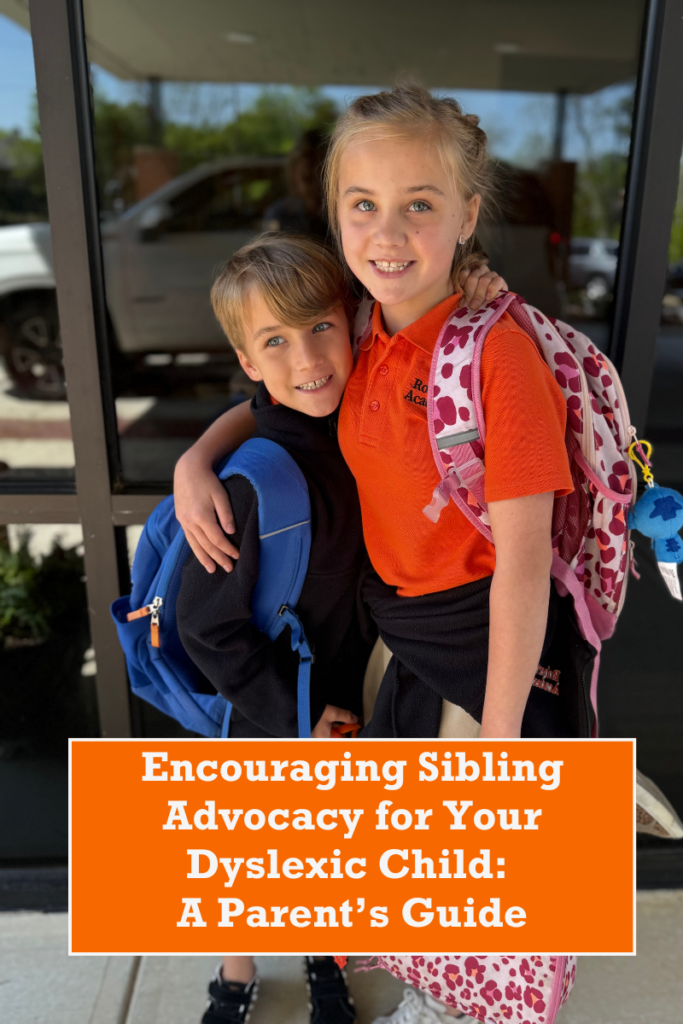When a child is diagnosed with dyslexia, the entire family is affected. While most of the attention often goes to the child with dyslexia, there’s another important person on this path: their sibling.
With the right guidance, siblings of children with dyslexia can become their brother or sister’s strongest supporters.
At Roberts Academy, a school for dyslexic students in Macon, Georgia, we believe in supporting the whole child—and that includes creating opportunities for siblings to grow alongside them.
Here’s how families can nurture advocacy, empathy, and connection between siblings.

Children can’t advocate for what they don’t understand. Help your child understand what dyslexia is—and what it isn’t—using simple, affirming language. Avoid technical jargon and instead try this:
“Dyslexia means your sibling’s brain works a little differently when it comes to reading. They’re just as smart—it’s just that their brain takes a different path to get there.
”Books, videos, and activities designed to help kids understand dyslexia can be great tools. Teaching siblings about how the dyslexic brain works builds both empathy and pride.
For example, “Fish in a Tree,” by Lynda Mullaly Hunt is a heartwarming story that helps families understand dyslexia through the journey of a young girl learning to embrace her unique strengths, offering hope and insight for those navigating a dyslexia diagnosis.
Related Blog Post: Dyslexia Resources for Parents, Educators, and Advocates
It’s easy for siblings to hear about what’s hard for their brother or sister—spelling tests, tutoring, or frustration with schoolwork. Make it a priority to also talk about how your dyslexic child excels. Share examples of their creativity, problem-solving, or storytelling.
Point out real-world figures or moments when your child’s unique brain shines. The goal is to help siblings see dyslexia as a strength, not a setback.
You don’t have to wait for big moments to teach advocacy. It often happens in the little things:
When parents notice these small acts and name them, it reinforces the message:
“I saw how you helped your sister today. That was so thoughtful—and a great example of being an advocate.”
This is how you build advocacy skills in siblings of students with learning differences.
Siblings may feel overlooked or confused by the extra support their brother or sister receives.
Normalize those feelings:
“It’s okay to feel frustrated or left out sometimes. That doesn’t make you a bad sibling—it just makes you human.”
Letting kids express those emotions without judgment helps prevent resentment and encourages more authentic relationships.
Not all kids are naturally outspoken—and that’s okay. Some siblings advocate through quiet gestures; others are more vocal. Give your child the freedom to find their way to support their sibling.
Lead by example. Let them observe how you talk about dyslexia to teachers, family members, or friends. Advocacy isn’t just something you talk about—it’s something they’ll learn from by watching you.
This gentle approach works well when you’re focused on teaching advocacy in neurodiverse families.
Invite siblings to help pick out books, attend school events, or use assistive tools like audiobooks together. These shared experiences build connection and reduce the chance of a “me vs. them” mindset.
Creating inclusive moments helps the whole family feel united and aligned, which is key in families navigating dyslexia together.
Celebrate the moments when your children encourage each other. Whether it’s working together on a puzzle or cheering from the sidelines, point it out:
“You two make a great team. I love the way you helped your brother stay calm during his homework.”
These affirmations remind siblings that their actions matter—and that they’re an important part of their sibling’s success.
At Roberts Academy, a dyslexia-focused elementary school in Georgia, we understand that dyslexia impacts more than just academics—it touches every aspect of a family’s life. That’s why we’re committed to providing resources, education, and support not just for students but for the entire family.
We believe that by equipping siblings with understanding, empathy, and advocacy skills, we’re helping build lifelong allies. Whether through school events, parent education nights, or one-on-one conversations, we encourage families to nurture those sibling bonds as a key part of a dyslexic child’s success story.
Helping your dyslexic child’s sibling become their advocate isn’t about putting pressure on them—it’s about empowering them to step into a role that’s rooted in love and understanding. Through education, empathy, and encouragement, siblings can become incredible allies—and maybe even lifelong advocates—for the dyslexic child in their life.
Discover Roberts Academy at Mercer University in Macon, Georgia!